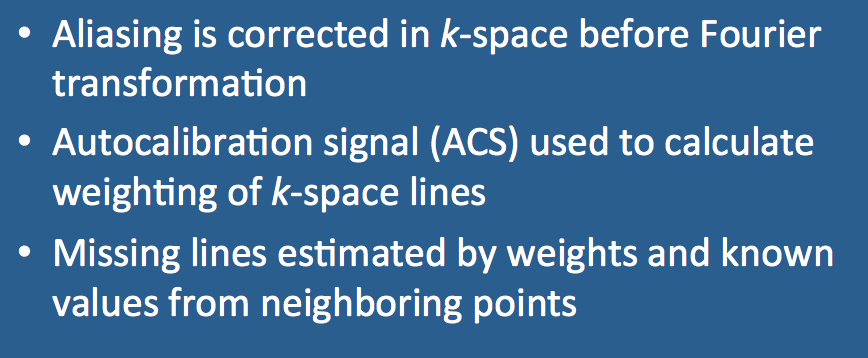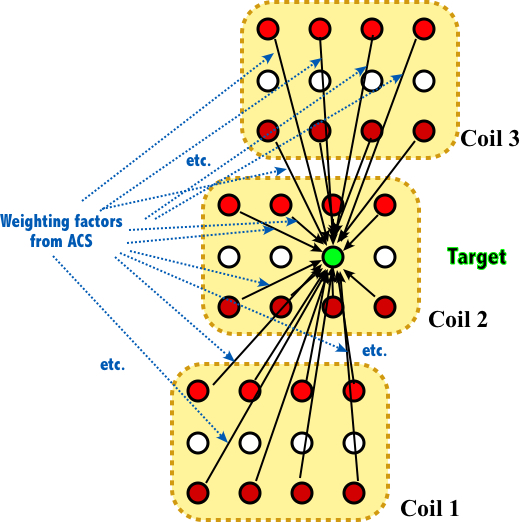GRAPPA (GeneRalized Autocalibrating Partial Parallel Acquisition) and ARC (Autocalibrating Reconstruction for Cartesian imaging) are multi-coil parallel imaging (PI) techniques. Like other PI methods (e.g. SENSE/ASSET), GRAPPA/ARC sample only a limited number of phase-encoding steps. Phase undersampling dramatically reduces imaging time but results in overlapping/aliased signals that must be untangled.
In SENSE/ASSET coil sensitivities are used to sort out these signals in the image domain after Fourier transformation. In GRAPPA/ARC the correction is made in k-space before Fourier transformation. It is sometimes said that:
SENSE/ASSET methods reconstruct, then correct.
GRAPPA/ARC methods correct, then reconstruct.
GRAPPA/ARC methods correct, then reconstruct.
The diagram below illustrates the four major steps in the GRAPPA/ARC process.
1. Data Acquisition. The acquired MR signals are digitized, demodulated, and used to fill the k-space matrix for each coil. Because multiple phase-encoding steps have been skipped, many k-space lines will be missing. Lines through the center of k-space, however, are fully sampled and constitute the autocalibration signal (ACS) region. These extra ACS lines are interspersed with image acquisition itself (hence the term, "autocalibrating").
2. Estimation of Missing Lines. Known data from the ACS are used to calculate weighting factors for each coil. These weighting factors reflect how each coil distorts, smears, and displaces spatial frequencies within the full FOV k-space data. Missing k-space points are estimated in an iterative fashion using these global weighting factors combined with local known data for each small region (known a block or kernel). It should be noted that weighting factors and known data from all coils are used to estimate missing data for each coil.
3. Generate Individual Coil Images. With the missing lines of k-space now filled, Fourier transformation is performed to create individual images from each coil. Unlike the coil images in SENSE/ASSET, these GRAPPA/ARC images are free from aliasing.
4. Combine. The individual coil images are at last combined using a sum of squares method into the final magnitude image.
The critical step in GRAPPA/ARC involves estimation of the missing points. Many variations are possible, including the size of the reconstruction kernel and number of parameters used. The major difference between GRAPPA and ARC is that the latter uses a 3D kernel to synthesize missing data taking into account neighboring source data from all three directions. A somewhat different estimation process is also employed in ARC to make the 3D data computations manageable.
Estimation of missing k-space data in GRAPPA/ARC. Here phase-encoding is along vertical axis.
Advanced Discussion (show/hide)»
In addition to their standard product, GE offers the option to run ARC in "Turbo Mode" to speed up the scan by up to a factor of 2. TurboARC adjusts the data sampling pattern to acquire fewer data points in the k-space periphery. The pattern of filling (centric vs elliptical centric) may also be adjusted.
References
Blaimer M, Breuer F, Mueller M, Heidemann RM, Griswold MA, Jakob PM. SMASH, SENSE, PILS, GRAPPA. How to choose the optimal method. Top Magn Reson Imaging 2004;15:223-236 [review].
Brau A. New parallel imaging method enhances imaging speed and accuracy. GE Signa Pulse, 2007; 36-38. (Promotional piece describing GE's ARC method).
Brau ACS, Beatty P, Skare S, Bammer R. Comparison of reconstruction accuracy and efficiency among autocalibrating data-driven parallel imaging methods. Magn Reson Med 2008; 59:382-395
Deshmane A, Gulani V, Griswold MA, Seiberlich N. Parallel MR imaging. J Magn Reson Imaging 2012;36:55-72. (review)
Griswold MA, Jakob PM, Heidemann RM, et al. Generalized autocalibrating partially parallel acquisitions (GRAPPA). Magn Reson Med 2002; 47:1202-1210
Blaimer M, Breuer F, Mueller M, Heidemann RM, Griswold MA, Jakob PM. SMASH, SENSE, PILS, GRAPPA. How to choose the optimal method. Top Magn Reson Imaging 2004;15:223-236 [review].
Brau A. New parallel imaging method enhances imaging speed and accuracy. GE Signa Pulse, 2007; 36-38. (Promotional piece describing GE's ARC method).
Brau ACS, Beatty P, Skare S, Bammer R. Comparison of reconstruction accuracy and efficiency among autocalibrating data-driven parallel imaging methods. Magn Reson Med 2008; 59:382-395
Deshmane A, Gulani V, Griswold MA, Seiberlich N. Parallel MR imaging. J Magn Reson Imaging 2012;36:55-72. (review)
Griswold MA, Jakob PM, Heidemann RM, et al. Generalized autocalibrating partially parallel acquisitions (GRAPPA). Magn Reson Med 2002; 47:1202-1210
Related Questions
Our scanner has two different options for parallel imaging (SENSE and GRAPPA). What are they and which should I use?
Our scanner has two different options for parallel imaging (SENSE and GRAPPA). What are they and which should I use?



